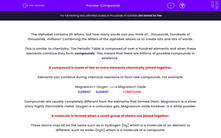The alphabet contains 26 letters, but how many words can you think of... thousands, hundreds of thousands, millions? Combining the letters of the alphabet allows us to create lots and lots of words.
.jpg)
This is similar to chemistry. The periodic table is composed of over a hundred elements, 118 in fact, and when these elements combine they form compounds. This means that there are billions of possible compounds in existence.
Each compound has a unique chemical formula. It is made up of symbols and numbers. The symbols tell us which elements are in the compound, and the numbers tell us how many atoms of each element are in a molecule of the compound.
Stearic acid has the formula:
C18H36O2
This means it contains 18 atoms of carbon, 36 atoms of hydrogen and 2 atoms of oxygen in a molecule of stearic acid. Woah that's a lot!!!
Let's have a go at some questions about chemical formulae.







